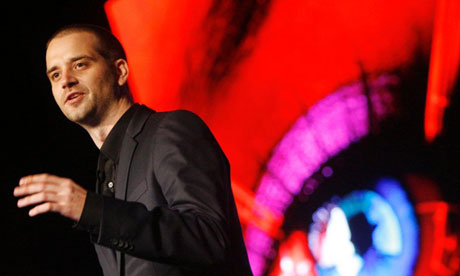
Daniel Chong, 25, will
receive $4.1 million to settle his claim for maltreatment. In 2012,
Chong was left for five days in a 5-by-10-foot windowless interrogation
room at a DEA facility without food, water or toilet facilities.
(K.C. Alfred, U-T San Diego / May 1, 2012)
SAN DIEGO— A college student mistakenly left in a Drug Enforcement
Administration interrogation room for five days without food or water
will receive $4.1 million from the federal government to settle his
claim for maltreatment.
The settlement, approved by the Department of Justice, was
announced Tuesday in San Diego by the student, Daniel Chong, 25, and
his lawyer, Eugene Iredale.
"It was an accident, a really, really bad, horrible accident," Chong said.
Iredale said Chong has undergone intensive
psychotherapy and been diagnosed with post-traumatic stress disorder.
What happened to Chong, Iredale said, "should never happen to any human being on the face of the planet."
The bizarre event began on the afternoon of April 20, 2012 — a
traditional counterculture day of celebration for smoking pot. Chong,
then an engineering student at UC San Diego, went to a house near campus
to smoke marijuana with friends and found himself swept up in a DEA
raid.
Officers from several police agencies raided the house and found
large quantities of ecstasy pills and hallucinogenic mushrooms, plus
weapons and ammunition, according to court documents. Unknown to Chong,
the house had been under surveillance for days.
Chong and eight suspects were taken into custody for interrogation.
After being questioned briefly at the DEA facility in San Diego, he was
told he would soon be released.
But, for reasons that remain unclear, Chong was left for five days in
a 5-by-10-foot windowless room without food, water or toilet
facilities. He quickly lost weight and was able to slip out of a pair of
handcuffs.
He suffered hallucinations. He tried to break a fire sprinkler to get
water but failed. Instead he said he had to drink his own urine to
survive. He screamed for help but soon became too weak. For the final
two days, Chong was in the dark, Iredale said.
Fearing that he would die, Chong broke his glasses and scrawled the message, "Sorry, mom," on his arm.
When he was discovered by DEA employees, Chong was covered in his own
feces and severely dehydrated. He was rushed to a hospital, close to
kidney failure and breathing with difficulty. He spent five days in the
hospital.
The Department of Justice's Office of Inspector General is investigating the incident.
Several theories have been advanced on how Chong could have been
forgotten. One is that the officer who questioned him that Friday
afternoon was not from the DEA but another agency. When that officer
left at day's end, he thought that someone else would release Chong.
The next two days were Saturday and Sunday, when fewer employees are
on duty. By Monday, Chong's cries may have been too weak to be heard
through the thick door of the interrogation cell, located down a narrow
hallway and isolated from the rest of the DEA facility.
Chong said that he did not scream at first, believing that he would
soon be released. "It seemed impossible for them to forget me," he said.
He remembers the shocked look on the faces of employees who finally
opened the door and saw him, exhausted, starving, possibly near death.
His body, he said, was shutting down.
Days later, a top DEA official apologized to Chong and ordered an "extensive review" of DEA procedures.
"I extend my deepest apologies [to] the young man and want to express
that this event is not indicative of the high standards that I hold my
employees to," said William R. Sherman, who was then acting special
agent in charge of the DEA's San Diego Division.
No charges were filed against Chong. Iredale filed a claim with the
agency, usually the first step toward a lawsuit. But in this case,
officials immediately began negotiating a settlement and listened to a
local psychologist who said that Chong was in worse shape than many
combat veterans he has treated, Iredale said.
The DEA review of its procedures for interrogations is not yet complete, a spokesman for the agency said Friday.
Iredale said he is confident that the agency has taken steps to
ensure that nothing similar happens at any of its 21 field stations. The
government has "recognized the profound suffering that David underwent
and the damages they caused."
Chong still receives therapy and has returned to finish his degree at
UCSD. He has changed his major to economics. He said he is glad to have his life "back to normal."
Neither the DEA nor the Department of Justice had a comment on the settlement.
Read More :
http://www.latimes.com/news/local/la-me-dea-settlement-20130731,0,5395826.story



























